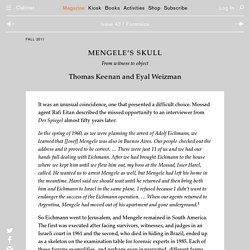

Cabinet Mag - Forensics / Issue 43. ARQUITECTURA Y ESTÉTICA FORENCE: mesa de discusión con Eyal Weizman, Thomas Keenan y Judy Radul. MENGELE ID`D BY VIDEO PROCESS. After all the evidence was in, it was a German pathologist who provided the key to identifying Josef Mengele.

Using a video-imaging process called skull-face superimposition, Richard Helmer was able to match a skull dug up from a hillside grave near Sao Paulo, Brazil, with photographs of the infamous Nazi death camp doctor. Last June, the West German government flew Helmer, a forensic pathologist at the University of Kiel outside of Hamburg, and two colleagues to Sao Paulo to work with a team of American and Brazilian forensic experts on the Mengele case. Earlier that month, an Austrian couple living in Brazil, Wolfram and Lisolette Bossert, had led the Sao Paulo police to a grave where, they said, Mengele had been buried in 1979 under a false name. The Bosserts, who befriended the Nazi fugitive shortly after his arrival in Brazil in 1963, claimed Mengele died in a swimming accident. ''At the onset of our investigation,'' Helmer says, ''we were all highly skeptical of the Bosserts` story.
Una estética forense. El “giro cultural hacia el yo” es cosa del pasado.

En una reflexión sobre el poder de las imágenes en los regímenes de construcción de verdad, La calavera de Mengele postula el advenimiento de un nuevo tipo de narrativa en la cual discurren la política, la organización social y sus instituciones, la esfera pública y con ellas, nuestros modos de vida: la estética forense. Ana García Orsi Año 1944. Pabellón 10 del campo de concentración de Auschwitz. Josef Mengele da rienda suelta a la imaginación científica: inyecta tintura azul en los ojos de un niño etiquetado como gitano, inocula la bacteria del cólera en el feto de una embarazada, cose por la espalda a dos bebés gemelos para fabricar siameses. Weizman Introduction Forensis libre. Restos que afectan. Estéticas forenses en el arte contemporáneo colombiano. Según Aristóteles (1999), la retórica forense es aquél discurso que busca persuadir sobre una posición respecto de un hecho del pasado, según categorías como lo justo y lo injusto, lo correcto y lo equivocado, lo verídico y lo falaz.

Eyal Weizman (2012) nos demuestra que, en la forma contemporánea de la retórica forense, tejida al hilo de la cientifización de la verdad y la prueba judicial, no sólo la palabra sino también los objetos pueden persuadir. Los objetos se pueden dirigir al foro; sin embargo, ellos no pueden hablar por sí mismos, por lo que es necesario que alguien los interprete. Es decir, su voz debe ser mediada. La estética forense, entendida por Weizman como las operaciones estéticas involucradas en la mediación de las voces de los objetos en el ámbito jurídico, encuentra un correlato en el arte contemporáneo, en el que una mediación similar ha sido una estrategia recurrente desde la década de los sesenta.
Imagen 1. Imagen 2. Imagen 3. Imagen 4. Imagen 5. Imagen 6. Notas. Mengele’s Skull From witness to object By Thomas Keenan and Eyal Weizman. The “era of testimony” began, by most accounts, with the trial of Eichmann in Jerusalem in 1961, the first major war crimes trial since Nuremberg and Tokyo and the crucible of all the great debates about international criminal justice and accounting for atrocities since.2 In the two chapters of The Juridical Unconscious devoted to Eichmann, Shoshana Felman argues that the new political agency of survivors as witnesses established at the trial was acquired not in spite of the fact that the stories they told were hard to tell, hear, or sometimes even to believe, not in spite of the fact that they were unreliable, but, paradoxically, precisely because of these flaws.

The case of Mengele, though—the path not taken and the trial that never happened—provides an instructive alternative to the story that seems to begin with Eichmann. The break in the Mengele case came shortly after that. The skeleton that emerged became the center of a major media event. But its status was soon contested. What is Forensic Aesthetics? In the fall of 1996, mere months after the optimism from the Oslo Accords had distilled across the Palestinian population, Eyal Weizman began “a year in the field” in Tel Aviv studying urban planning.

A graduate student with London’s Architecture Association School, Weizman worked in Ramallah with the Palestinian Ministry of Planning (PMP) (McKee and McLagan). He was asked as the only Israeli among Palestinian and Norwegian planners to access Israel’s restricted cartography archives. In a time before satellite imagery became accessible via the internet, the PMP sought evidence of Israel’s settlement incursions into and further militarization of Palestine. Within days Weizman found images that contradicted many of Oslo’s promises. Where Oslo mandated imminent Palestinian political autonomy, regional peace, and the right of return for its diaspora, the photos and maps revealed Israeli’s brisk dismantling of Palestine’s infrastructure.
Works Cited Keenan, Thomas and Eyal Weizman. —-. —-.